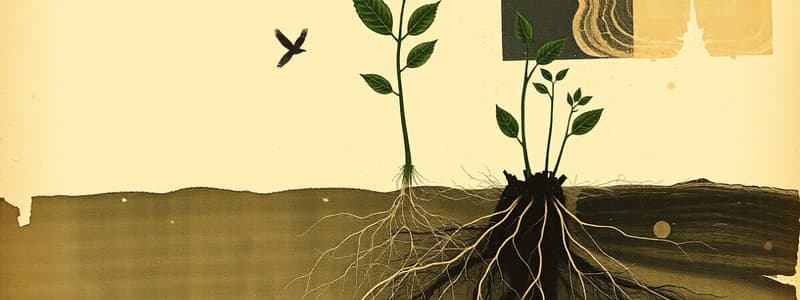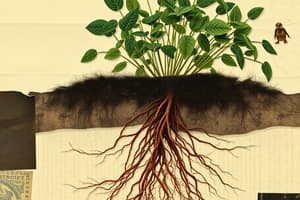Podcast
Questions and Answers
Which of the following best explains the relationship between photosynthesis and cellular respiration?
Which of the following best explains the relationship between photosynthesis and cellular respiration?
- Photosynthesis and cellular respiration are independent processes that do not affect each other.
- Photosynthesis and cellular respiration both produce ATP directly from sunlight.
- Cellular respiration produces glucose, which is then used in photosynthesis to create ATP.
- Photosynthesis produces glucose, which is then used in cellular respiration to create ATP. (correct)
A plant is unable to produce flowers. What is the most likely consequence of this?
A plant is unable to produce flowers. What is the most likely consequence of this?
- The plant will be unable to support its leaves and branches.
- The plant will be unable to transport water and nutrients.
- The plant will be unable to perform photosynthesis.
- The plant will be unable to reproduce sexually. (correct)
If a plant's stem is damaged, which of the following functions would be most directly affected?
If a plant's stem is damaged, which of the following functions would be most directly affected?
- Transport of water and nutrients throughout the plant. (correct)
- Production of pollen for reproduction.
- Absorption of sunlight for photosynthesis.
- Regulation of water loss through transpiration.
Within a chloroplast, which specific structure is responsible for trapping solar energy to initiate photosynthesis?
Within a chloroplast, which specific structure is responsible for trapping solar energy to initiate photosynthesis?
Wind is an important abiotic factor for plant reproduction. Which of the options is most likely describing the role of wind?
Wind is an important abiotic factor for plant reproduction. Which of the options is most likely describing the role of wind?
Which of the following best explains the role of phloem in a plant's vascular system?
Which of the following best explains the role of phloem in a plant's vascular system?
A plant is developing bark on its stems and roots. Which type of tissue is primarily responsible for this?
A plant is developing bark on its stems and roots. Which type of tissue is primarily responsible for this?
In which region of the plant does cell division primarily occur, leading to growth?
In which region of the plant does cell division primarily occur, leading to growth?
What is the primary function of the leaf system in plants?
What is the primary function of the leaf system in plants?
A scientist discovers a new plant species with exceptionally efficient water absorption. Which tissue type is most likely highly developed in its root system?
A scientist discovers a new plant species with exceptionally efficient water absorption. Which tissue type is most likely highly developed in its root system?
How do plants exchange gases with their environment, and why is it important?
How do plants exchange gases with their environment, and why is it important?
What is the role of the secondary meristem in plant growth?
What is the role of the secondary meristem in plant growth?
If a plant is unable to transport water and minerals efficiently from its roots to its leaves, which tissue is most likely to be damaged?
If a plant is unable to transport water and minerals efficiently from its roots to its leaves, which tissue is most likely to be damaged?
Flashcards
Chloroplast
Chloroplast
Organelle containing thylakoids stacked in discs for photosynthesis.
Pollination
Pollination
Process where pollen fertilizes ovules, leading to seed formation.
Photosynthesis
Photosynthesis
Process by which leaves convert water and carbon dioxide into glucose and oxygen using solar energy.
Cellular respiration
Cellular respiration
Signup and view all the flashcards
Functions of the stem
Functions of the stem
Signup and view all the flashcards
Plant systems
Plant systems
Signup and view all the flashcards
Root system
Root system
Signup and view all the flashcards
Dermal tissue
Dermal tissue
Signup and view all the flashcards
Vascular tissue
Vascular tissue
Signup and view all the flashcards
Apical meristem
Apical meristem
Signup and view all the flashcards
Xylem
Xylem
Signup and view all the flashcards
Phloem
Phloem
Signup and view all the flashcards
Study Notes
Plant Systems Overview
- Plants are multicellular organisms, typically green due to chlorophyll, and immobile.
- Flowering plants differ structurally from mosses, ferns, and conifers.
- Plant systems are categorized into root and foliaceous (leaf) systems.
- Plants produce their own food through photosynthesis.
- Plants do not require complex systems like digestion, movement, or a nervous system.
- Plants' essential functions include gas exchange and circulation.
- Roots are usually below ground, absorbing majority of water and minerals.
Root System
- The root system anchors the plant, often extending extensively underground.
- Roots absorb water and minerals.
- Roots form a complex structure of dermal, fundamental, and vascular tissues to fulfill these roles.
- Roots are a valuable food source, including carrots and sugar beets.
Plant Tissues
- Plant tissues include dermal, fundamental, and vascular tissues.
- Dermal tissues form the outer layer and include epidermal and peridermal tissues.
- Epidermal tissue is a thin outer layer covering non-woody parts.
- Peridermal tissue forms bark on stems and roots.
- Dermal tissues absorb water and minerals, create a waxy surface for protection, and produce defensive structures like hairs containing irritants.
- Fundamental tissues perform various functions depending on location.
- Vascular tissues (xylem and phloem) are responsible for transport.
- Xylem transports water and minerals upwards.
- Phloem transports sugars (glucose) and hormones throughout the plant.
- Vascular tissues connect dermal and fundamental tissues, and store nutrients in roots and stems.
Plant Growth
- Plant growth involves apical and secondary meristems.
- Apical meristems are regions of cell division, contributing to growth.
- Elongation region: cells lengthen.
- Maturation region: cells specialize into tissues.
- Secondary meristems enable diameter growth.
- Secondary merstems produce new layers of dermal tissue (cork), inner phloem, and inner xylem.
Plant Parts and Their Roles
- Plant parts include stems, roots, and leaves.
- Leaves are the primary photosynthetic organs.
- They use light energy, carbon dioxide, and water to produce glucose and oxygen.
- Contain chloroplasts with thylakoids for photosynthesis.
- Flowers are reproductive organs.
- Contain male (pollen) and/or female (ovules) reproductive structures.
- Fertilization leads to seed production within the fruit.
- Stems support leaves, flowers, and transport substances between roots and leaves.
Photosynthesis and Cellular Respiration
- Photosynthesis: Plants use solar energy, water, and carbon dioxide to produce glucose and oxygen.
- Cellular Respiration: Cells break down glucose in the presence of oxygen to create ATP (energy), releasing carbon dioxide and water as byproducts.
Studying That Suits You
Use AI to generate personalized quizzes and flashcards to suit your learning preferences.




